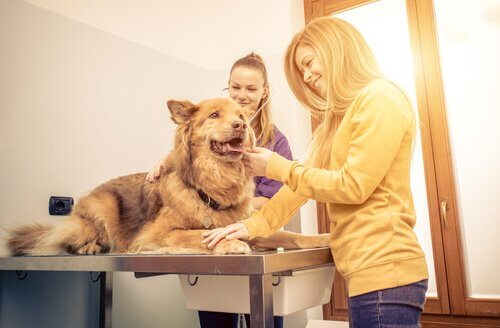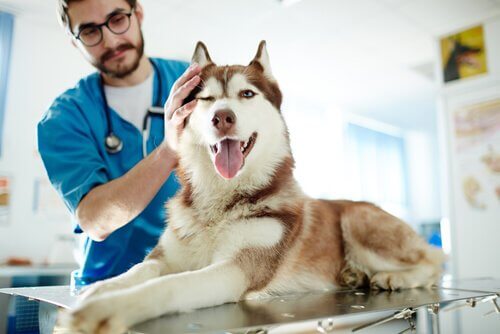Precautions to Take When Taking a Dog to the Vet

No one ever said taking a dog to the vet was easy. However, there are certain tricks and techniques that you can use to make the experience a better one, and avoid potential trauma.
How to take a dog to the vet
Going to the vet is one of the most stressful things a pet can do. That’s understandable, because he has to put up with being examined, getting shots, and taking medicine. In addition, the veterinary clinic is an unfamiliar place, and there will probably be other animals there too.
It’s important to put ourselves in their place, and understand that they don’t behave badly on purpose. They do so out of fear or ignorance. Therefore, our role as owners is to make their experience at the vet as enjoyable as possible.
Taking a dog to the vet isn’t an easy task. However, it’s a necessary one, because we need to check make regular checks on their health and treat any possible illnesses. Of course, your pet doesn’t know that. He has to face trauma like strange smells, unknown noises, and people he has never seen before. In addition, he may even have to deal with his owner’s nervousness.
Therefore, it’s important to teach your pet that a visit to the vet isn’t a bad thing. To do that, you have to bring your pet to the vet periodically. That way, he’ll end up getting used to it–although that doesn’t mean he’ll get to love it! However, he’ll feel a bit better about it.

Tips for taking your dog to the vet
Even if he doesn’t like going to the vet, he needs a checkup at least twice a year. He may need to go more frequently if the vet considers it appropriate. So, what can you do to make your dog feel less nervous or traumatized when you take him to the vet? Here are some tips:
1. Don’t tell him where you’re going
One of the most common mistakes that owners make is telling their pets where they’re going. Saying, “Let’s go to the vet!” is the same as telling him that he’s going to have a terrible time. Don’t forget that animals understand a handful of specific words, and “vet” is probably one of them.
When you go to the vet, don’t always take the same route. That way, the dog won’t associate that route with a visit to the vet.
2. He’ll behave better if he’s tired
A good technique for taking the dog to the vet is to have him expend most of his daily energy playing, running, or walking in the park. In addition, the physical activity will help him de-stress. That way, he won’t be so nervous later on.
3. Let him get to know the vet
As soon as he gets on the vet’s table, let him get to know the veterinarian. Let him smell his hands and greet him. If you don’t allow him to do so, he’ll probably get scared.
The size of the dog doesn’t matter. Whether its a chihuahua or a boxer, do your best to help him not be afraid of the vet.

4. Talk to him the whole time
As soon as you arrive at the clinic until the time you go home, it’s important to keep the “conversation” going with your pet. Talk to him using kind words, in a calm, soft tone. That way he won’t panic or feel like danger is near.
Don’t scold him, unless it’s extremely necessary. If other animals are around, give him the specific order to sit still by your side. Avoid yelling at him, since that will make him more nervous.
5. Stay by his side the entire time
Dogs need to be next to their “leader” to feel safe and calm. In addition, they need to know that their owner is feeling calm, too. Therefore, you need to calm yourself down first, so that you, in turn, can calm your pet.
Stay by your dog’s side when you enter the veterinarian clinic, while you wait for the vet to come, while the vet examines him, and on the way home. That way the animal will not feel frightened.
6. Reward good behavior
Whether you do it after the vet examines your dog or when you get home, it’s important to give him a treat. Do it not only to reward good behavior, but also so that the animal associates the vet with a toy, treats, or petting.
Taking the dog to the vet isn’t an easy task. However, even if he doesn’t like it, it must be done. With these tips, your experience should be a more enjoyable one, and there will be less trauma and bad behavior.
No one ever said taking a dog to the vet was easy. However, there are certain tricks and techniques that you can use to make the experience a better one, and avoid potential trauma.
How to take a dog to the vet
Going to the vet is one of the most stressful things a pet can do. That’s understandable, because he has to put up with being examined, getting shots, and taking medicine. In addition, the veterinary clinic is an unfamiliar place, and there will probably be other animals there too.
It’s important to put ourselves in their place, and understand that they don’t behave badly on purpose. They do so out of fear or ignorance. Therefore, our role as owners is to make their experience at the vet as enjoyable as possible.
Taking a dog to the vet isn’t an easy task. However, it’s a necessary one, because we need to check make regular checks on their health and treat any possible illnesses. Of course, your pet doesn’t know that. He has to face trauma like strange smells, unknown noises, and people he has never seen before. In addition, he may even have to deal with his owner’s nervousness.
Therefore, it’s important to teach your pet that a visit to the vet isn’t a bad thing. To do that, you have to bring your pet to the vet periodically. That way, he’ll end up getting used to it–although that doesn’t mean he’ll get to love it! However, he’ll feel a bit better about it.

Tips for taking your dog to the vet
Even if he doesn’t like going to the vet, he needs a checkup at least twice a year. He may need to go more frequently if the vet considers it appropriate. So, what can you do to make your dog feel less nervous or traumatized when you take him to the vet? Here are some tips:
1. Don’t tell him where you’re going
One of the most common mistakes that owners make is telling their pets where they’re going. Saying, “Let’s go to the vet!” is the same as telling him that he’s going to have a terrible time. Don’t forget that animals understand a handful of specific words, and “vet” is probably one of them.
When you go to the vet, don’t always take the same route. That way, the dog won’t associate that route with a visit to the vet.
2. He’ll behave better if he’s tired
A good technique for taking the dog to the vet is to have him expend most of his daily energy playing, running, or walking in the park. In addition, the physical activity will help him de-stress. That way, he won’t be so nervous later on.
3. Let him get to know the vet
As soon as he gets on the vet’s table, let him get to know the veterinarian. Let him smell his hands and greet him. If you don’t allow him to do so, he’ll probably get scared.
The size of the dog doesn’t matter. Whether its a chihuahua or a boxer, do your best to help him not be afraid of the vet.

4. Talk to him the whole time
As soon as you arrive at the clinic until the time you go home, it’s important to keep the “conversation” going with your pet. Talk to him using kind words, in a calm, soft tone. That way he won’t panic or feel like danger is near.
Don’t scold him, unless it’s extremely necessary. If other animals are around, give him the specific order to sit still by your side. Avoid yelling at him, since that will make him more nervous.
5. Stay by his side the entire time
Dogs need to be next to their “leader” to feel safe and calm. In addition, they need to know that their owner is feeling calm, too. Therefore, you need to calm yourself down first, so that you, in turn, can calm your pet.
Stay by your dog’s side when you enter the veterinarian clinic, while you wait for the vet to come, while the vet examines him, and on the way home. That way the animal will not feel frightened.
6. Reward good behavior
Whether you do it after the vet examines your dog or when you get home, it’s important to give him a treat. Do it not only to reward good behavior, but also so that the animal associates the vet with a toy, treats, or petting.
Taking the dog to the vet isn’t an easy task. However, even if he doesn’t like it, it must be done. With these tips, your experience should be a more enjoyable one, and there will be less trauma and bad behavior.
All cited sources were thoroughly reviewed by our team to ensure their quality, reliability, currency, and validity. The bibliography of this article was considered reliable and of academic or scientific accuracy.
Espinoza Liset. (2015). Conozca las enfermedades que más padecen las mascotas.
This text is provided for informational purposes only and does not replace consultation with a professional. If in doubt, consult your specialist.








